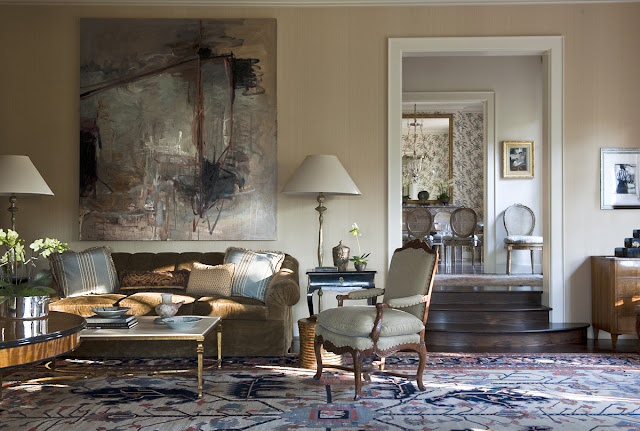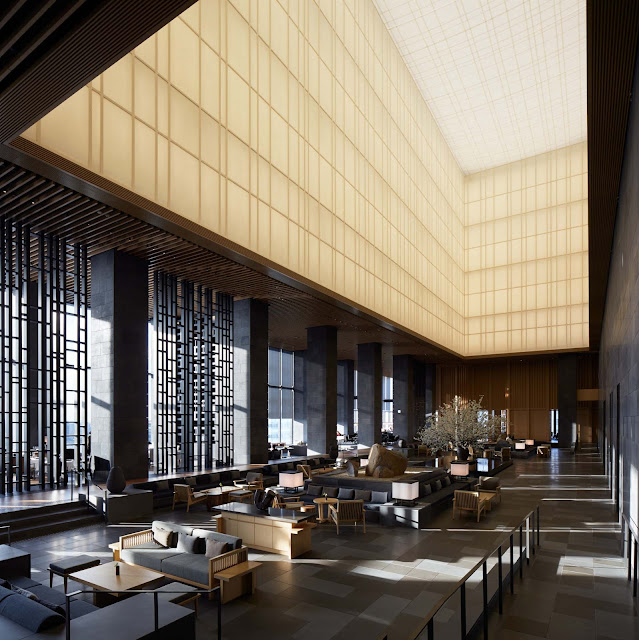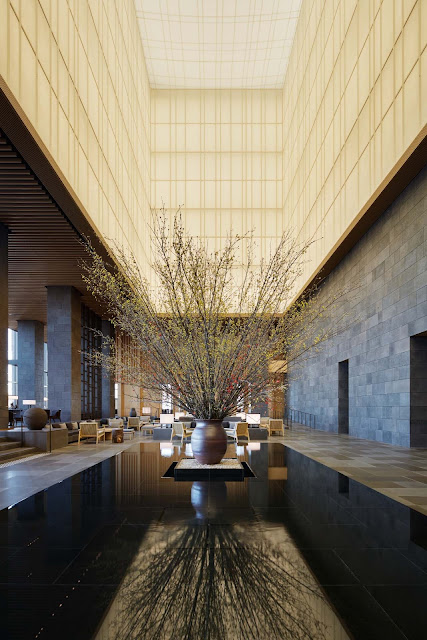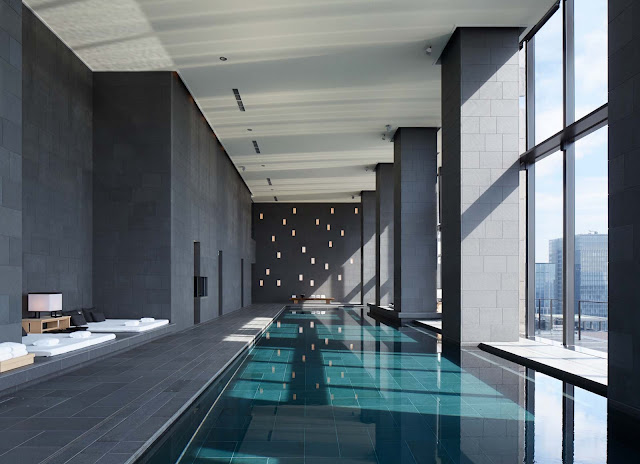This month marks exactly thirty-one years since Tim Marks and interior designer, Suzanne Tucker, incorporated their acclaimed design firm, which now has more than thirty design staff in its downtown San Francisco headquarters, and projects around the globe.
Tim and Suzanne are beloved leaders of the San Francisco design world. They direct a highly successful company producing the best interior décor, along with fabric collections, linens collections, and elegant products and books.
Suzanne is the principal designer at Tucker & Marks. Timothy Marks is the Managing Principal and CFO, and he handles the business side of the company, Suzanne handles the design side. It’s a perfect and highly successful partnership.
For over three decades, Tim and Suzanne have generously lead a range of lively community involvement, from design education fund-raisers to education seminars.
I admire their inspired initiation of design events, as well as their founding of the Northern California chapter of the Institute for Classical Architecture. I admire Suzanne’s continued leadership, with Arianne Trimuchat, of the San Francisco Fall Antiques and Art Show.
This week, I’ve gathered a portfolio of my favorite interiors by Tucker & Marks, and insights from Suzanne about design today, enduring and classical design, and what makes her tick (for thirty-one years). There’s a preview of the beautiful new textiles collections. Come with me to enjoy the interiors and ideas. Here’s wishing many more years of Tucker & Marks.
San Francisco interior designer Suzanne Tucker has been acclaimed for the exceptional style and intelligence of her work since she and her husband, Tim, launched their internationally acclaimed firm, Tucker & Marks, over three decades ago. Tucker is an iconic member of the international design community.
The Northern California Chapter of the Institute Of Classical Architecture & Art (ICAA) recently honored Suzanne for three decades of devotion to the design world, her philanthropy and her leadership.
Suzanne founded the ICAA Northern California Julia Morgan Awards. She launched a prestigious design lecture series at the annual San Francisco Fall Art & Antiques Show. For over a decade, Tucker has sponsored design and architecture student scholarships for the group.
“Design education is my obsession because students coming out of school don’t have the classical training that is a crucial foundation for any design discipline, with architecture and interior design chief among them,” said Suzanne.
Suzanne is in demand for her timeless style, and her in-depth knowledge and understanding of architecture and the decorative arts. She worked closely with the legendary Michael Taylor in the early eighties, and she is often referenced as his protégée.
“My work has remained grounded in classic design. Perhaps it was the strong mentoring I had from Michael Taylor, but scale and proportion will always be paramount to style,” said Tucker. “Good design transcends trends. Color and style are subjective, but today educated collectors buy very good art, seek out the best furniture whether new or antique, and are in search of timeless design.”
Tucker grew up immersed in Santa Barbara and among Montecito’s fruit groves, historic mansions and lavish estates.
In 1992, she and Tim acquired a former farm storage barn that had been remodeled into a weekend cottage, with a pool and sheltered garden and terrace.
As Tucker and Marks established their design firm in San Francisco, the bungalow became their family gathering place, chic but relaxed.
“The house is incredibly simple, humble really but it is all we need to be very happy,” said Tucker. It's an open-plan layout – just a living room/dining area opening onto the kitchen, and with only two bedrooms, a master and guest.
In addition, Tucker directs the highly successful Suzanne Tucker Home collection and recently introduced a stunning new collection of fine decorative textiles. She launched her fabric designs with a glittering party in Paris. She used many of her textiles in the Montecito retreat.
“I based many of the designs on historical documents and rare antique textiles, as well as historical gardens, art, and ” said Tucker. “The concept is a rich range of silk and cotton damasks, linens, velvets, and simple cottons that can be very versatile in today’s interiors.”
Future Suzanne Tucker Home collections will include wallpaper, tabletop, lighting and furniture.
Suzanne and her firm have created an in-depth resource list of exceptionally talented artisans.
“Via the Internet, artists, textile designers, and craftsmen and creators from around the world are accessible and able to be contacted and supported. These are both very new arts and crafts, and as well arts that must be passed on to future generations, so that they cannot disappear, “ she said. “I believe in supporting craftsmanship and employing these artisans whenever possible. I love to see the eye and the hand of the artist. Ever the dreamer and always the romantic am I.”
The future of design includes both the most advanced tech—and the richness of the most ancient arts, said Suzanne.
“For interiors that are personal and rewarding,” she added. “I love to see the liveliness of modern design, the inspiration of paintings and sculpture, and beautiful woods, elegant materials, fine crafts and arts. This is an exciting time for design. We can enjoy the best of contemporary ideas, and warm our souls with ideas and skills of many eras.”
Here’s to many more years for Tucker & Marks.
The collection includes:
CRIQUET - Imaginative with inspired entomology, Criquet features only the sweetest critters recreated from Suzanne’s personal textile collections. Stylish yet primitive, in a two-tone print on a distressed linen ground, the finished look was inspired by the vintage techniques of batik and wax resists.
Papyrus: With a touch of Art Deco and a nod to Egyptomania, THE stylized papyrus leaf pattern is both chic and timeless
Tangiers: The patterns of Morocco, Spain and Portugal inspired this elegant and bold design we named ‘Tangiers’ – the exotic gateway between Africa and Europe.
Treillage: A modern take on the classic trellis pattern combines skillful embroidery and appliqué, resulting in a versatile design that works within a wide variety of design vocabularies, from contemporary to traditional.
For more information:
Edward Addeo
Matthew Millman
Michal Venera
Roger Davies
Tim and Suzanne are beloved leaders of the San Francisco design world. They direct a highly successful company producing the best interior décor, along with fabric collections, linens collections, and elegant products and books.
Suzanne is the principal designer at Tucker & Marks. Timothy Marks is the Managing Principal and CFO, and he handles the business side of the company, Suzanne handles the design side. It’s a perfect and highly successful partnership.
For over three decades, Tim and Suzanne have generously lead a range of lively community involvement, from design education fund-raisers to education seminars.
I admire their inspired initiation of design events, as well as their founding of the Northern California chapter of the Institute for Classical Architecture. I admire Suzanne’s continued leadership, with Arianne Trimuchat, of the San Francisco Fall Antiques and Art Show.
This week, I’ve gathered a portfolio of my favorite interiors by Tucker & Marks, and insights from Suzanne about design today, enduring and classical design, and what makes her tick (for thirty-one years). There’s a preview of the beautiful new textiles collections. Come with me to enjoy the interiors and ideas. Here’s wishing many more years of Tucker & Marks.
San Francisco interior designer Suzanne Tucker has been acclaimed for the exceptional style and intelligence of her work since she and her husband, Tim, launched their internationally acclaimed firm, Tucker & Marks, over three decades ago. Tucker is an iconic member of the international design community.
The Northern California Chapter of the Institute Of Classical Architecture & Art (ICAA) recently honored Suzanne for three decades of devotion to the design world, her philanthropy and her leadership.
Suzanne founded the ICAA Northern California Julia Morgan Awards. She launched a prestigious design lecture series at the annual San Francisco Fall Art & Antiques Show. For over a decade, Tucker has sponsored design and architecture student scholarships for the group.
“Design education is my obsession because students coming out of school don’t have the classical training that is a crucial foundation for any design discipline, with architecture and interior design chief among them,” said Suzanne.
Suzanne is in demand for her timeless style, and her in-depth knowledge and understanding of architecture and the decorative arts. She worked closely with the legendary Michael Taylor in the early eighties, and she is often referenced as his protégée.
“My work has remained grounded in classic design. Perhaps it was the strong mentoring I had from Michael Taylor, but scale and proportion will always be paramount to style,” said Tucker. “Good design transcends trends. Color and style are subjective, but today educated collectors buy very good art, seek out the best furniture whether new or antique, and are in search of timeless design.”
Escape to Montecito
Suzanne Tucker and Tim Marks divide their busy life between a bay-view Mediterranean-style house in Sausalito, their downtown San Francisco office (with a design staff of thirty) and a charming cottage hidden on a quiet hillside in Montecito.Tucker grew up immersed in Santa Barbara and among Montecito’s fruit groves, historic mansions and lavish estates.
In 1992, she and Tim acquired a former farm storage barn that had been remodeled into a weekend cottage, with a pool and sheltered garden and terrace.
As Tucker and Marks established their design firm in San Francisco, the bungalow became their family gathering place, chic but relaxed.
“The house is incredibly simple, humble really but it is all we need to be very happy,” said Tucker. It's an open-plan layout – just a living room/dining area opening onto the kitchen, and with only two bedrooms, a master and guest.
Tucker, admired for superbly detailed rooms with lavish custom curtains, decorative painted walls, and handsomely proportioned sofas, is also an expert at creating comfortable simplicity.
In the Montecito living room, custom upholstered chairs with white cotton denim slipcovers and a matching ottoman were given a shot of color with indigo Shibori pillows, and a vintage batik textile throw. Tucker’s collection of heirloom blue and white Chinese porcelain urns add complexity to the mix.
In the Montecito living room, custom upholstered chairs with white cotton denim slipcovers and a matching ottoman were given a shot of color with indigo Shibori pillows, and a vintage batik textile throw. Tucker’s collection of heirloom blue and white Chinese porcelain urns add complexity to the mix.
In addition, Tucker directs the highly successful Suzanne Tucker Home collection and recently introduced a stunning new collection of fine decorative textiles. She launched her fabric designs with a glittering party in Paris. She used many of her textiles in the Montecito retreat.
“I based many of the designs on historical documents and rare antique textiles, as well as historical gardens, art, and ” said Tucker. “The concept is a rich range of silk and cotton damasks, linens, velvets, and simple cottons that can be very versatile in today’s interiors.”
Future Suzanne Tucker Home collections will include wallpaper, tabletop, lighting and furniture.
The Future of Design
“The design world is thrilling now on so many levels whether one is a novice or a pro, a do-it-yourself designer, or the multi-homeowner, downtown or country,” noted Suzanne. “It can be exciting and overwhelming at the same time with zillions of options to which we all have access.”Suzanne and her firm have created an in-depth resource list of exceptionally talented artisans.
“Via the Internet, artists, textile designers, and craftsmen and creators from around the world are accessible and able to be contacted and supported. These are both very new arts and crafts, and as well arts that must be passed on to future generations, so that they cannot disappear, “ she said. “I believe in supporting craftsmanship and employing these artisans whenever possible. I love to see the eye and the hand of the artist. Ever the dreamer and always the romantic am I.”
The future of design includes both the most advanced tech—and the richness of the most ancient arts, said Suzanne.
“For interiors that are personal and rewarding,” she added. “I love to see the liveliness of modern design, the inspiration of paintings and sculpture, and beautiful woods, elegant materials, fine crafts and arts. This is an exciting time for design. We can enjoy the best of contemporary ideas, and warm our souls with ideas and skills of many eras.”
Here’s to many more years for Tucker & Marks.
Suzanne Tucker Home: Textiles and Embroidered Bed Collections
For April 2018, there are five new signature patterns for Suzanne Tucker Home. Each design is a detailed, multi-layered print with sophisticated color on soft cotton or linen grounds, with the name, Printemps.
The collection includes:
PARADIS - Paradis is a finely rendered depiction of exotic birds and fruits – including a signature Suzanne Tucker Home pomegranate. Printed on a 100% linen ground with a vintage color palette and slightly distressed background, Paradis has an abundance of character and luscious personality.
INDIENNE - Inspired by the formal landscaping surrounding the Taj Mahal as well as the Indian technique of hand block printing, Indienne is a large scale print, featuring potted topiaries in a lush garden populated by strutting peacocks and lush blooms. Sketched in a loose watercolor technique and finished with a border on one side, Indienne is bold, timeless and ever so chic.
FANTASIE - Fantasie depicts an enchanted forest populated with swirling vines, mesmerizing blossoms and charming, quirky creatures. An intricately detailed whimsy in three entirely different colorways to suit a wide variety of decorating vocabularies, Fantasie beguiles our imaginations.
LUCRECE - Lucrece features a perfectly laid out assortment of buds and blooms, so lush you can practically pick up their scents. Imagine lilacs, peonies, lilies and passion flowers, wonderfully rendered in a sophisticated tonal color palette and printed on 100% linen ground.
CRIQUET - Imaginative with inspired entomology, Criquet features only the sweetest critters recreated from Suzanne’s personal textile collections. Stylish yet primitive, in a two-tone print on a distressed linen ground, the finished look was inspired by the vintage techniques of batik and wax resists.
Suzanne Tucker Home Collection for Julia B.
This collaboration evolved from a loyal and longstanding relationship to a creative partnership.
For this first collection, there are elements from signature Suzanne Tucker Home textiles, as well as fragments from antique documents and linens, to create five timeless designs. All Julia B. embroidery and appliqué is crafted entirely by hand, following the centuries old French legacy of craftsmanship that has been passed down for generations. The bedding uses 100% cotton & 100% linen fabrics which have been sourced from the Europe.
For this first collection, there are elements from signature Suzanne Tucker Home textiles, as well as fragments from antique documents and linens, to create five timeless designs. All Julia B. embroidery and appliqué is crafted entirely by hand, following the centuries old French legacy of craftsmanship that has been passed down for generations. The bedding uses 100% cotton & 100% linen fabrics which have been sourced from the Europe.
Papyrus: With a touch of Art Deco and a nod to Egyptomania, THE stylized papyrus leaf pattern is both chic and timeless
Tangiers: The patterns of Morocco, Spain and Portugal inspired this elegant and bold design we named ‘Tangiers’ – the exotic gateway between Africa and Europe.
Treillage: A modern take on the classic trellis pattern combines skillful embroidery and appliqué, resulting in a versatile design that works within a wide variety of design vocabularies, from contemporary to traditional.
For more information:
Tucker & Marks
www.tuckerandmarks.com
Institute of Classical Architecture, Northern California:
Institute of Classical Architecture, Northern California:
www.classicist-nocal.org PHOTOGRAPHY CREDITS:
Matthew Millman
Michal Venera
Roger Davies


























































































